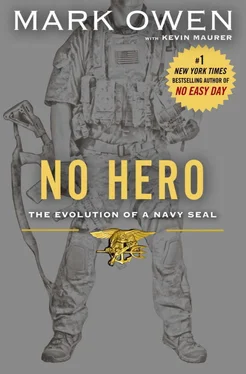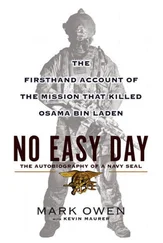As we approached the second door on the right side of the hallway, I stepped past it as my teammates behind me entered the room. As we got to the last door along the hallway on the left, my teammates smashed it open and flooded inside. I could hear yelling from the guys in the second room on the right side of the hallway. They found an AK-47, but there was no sign of the gunman.
Directly in front of me at the end of the hallway was the door to the balcony. I reached out and tried the handle. It was locked. My teammates had found an AK-47, but no one knew where the gunman had gone. I had an idea.
I thought through the risks. Did he have a suicide vest on? Was there more than one shooter? There was still no sign of him inside. I was starting to get nervous. How had the motherfucker gotten away already?
He couldn’t go down the steps. I took a knee and quickly unjammed my M-4. I unlocked the balcony door and slowly opened it up. Maybe he was hiding outside. It hadn’t dawned on me that there was no way he could have escaped outside and locked the door from the inside. It had all happened so quickly, and there was so much stuff going on around me it was hard to focus on the little things, like the balcony door being locked from the inside. I was obviously a bit overwhelmed. The whole fight was like being in a car accident.
———
Whenyou’re in a car accident, you probably remember the last two to three seconds leading up to the crash. If you were in another car accident, and then another and another, you would begin to remember more and more details about what happened to cause each crash, as you got more familiar with the sights, smells, sounds, rhythms, and speed of a crash.
Gunfights are like car crashes to some degree. They are things you try to avoid, they always surprise you when they happen, and because of the rush of adrenaline, it can become hard to focus and make good decisions. This was one of my first firefights, and I was having trouble staying focused.
With my M-4 jam cleared and the rifle back in action, I opened the door and cleared out onto the balcony.
No one was there. Where the fuck had he gone? I walked down to the end of the balcony, searching the courtyard below and the roof above. I could see our idling trucks in front of the house. There was no way he could have jumped down and escaped. The gunman had vanished.
At the end of the balcony I peered into the window of the room where they’d found the AK-47. I could see my teammates standing in the room. It looked like they’d searched under the beds and in the wooden armoire at the far end of the room.
I was about to walk back into the house when I spotted an adult male through the window, inside the room with my teammates. He was tucked in the windowsill, hidden by a piece of furniture. The male was in his early twenties, wearing a wife-beater T-shirt and shorts. His hair was a mess and he had a few wisps of a beard on his cheeks. His knees were pressed into his chest and I could tell he was trying to be as still as possible. He had his eyes closed and he had no idea I could see him.
I leveled my M-4, but I couldn’t shoot. He was unarmed, and besides, my teammates were standing behind him and a stray bullet could hit them. Thick black metal bars covered the window. I slid the barrel of my rifle between the bars and smashed the glass. The breaking glass startled the gunman and he turned to face me.
I reared back and drove the muzzle of my rifle into his face. His head snapped back and his lip split open, sending blood cascading down his chin and onto his dirty wife-beater T-shirt. He groaned and fell out of the windowsill onto the bedroom floor. Some of my teammates grabbed him, flipped him over on his face, and cuffed him with a plastic zip tie. We found out afterward he was the Iraqi officer’s son. He’d ditched his AK-47 before hiding in the windowsill.
It was impossible for me to focus once we got back to base that night. I kept going over the mission in my head. The guys who found the AK-47 should have found the son, but none of us managed the stress of the situation very well.
It wasn’t until a couple years later, and the hooded box test, that I started to really think about how to manage stress. I learned there that the key was to first prioritize all the individual stressors and then act. I break it all down into the little things I can manage. The stressors that I can’t affect, I don’t worry about. The ones I can affect, I simply deal with one at a time. In a lot of ways, it goes back to BUD/S and the elephant.
You know, how do you eat an elephant? One bite at a time.
The hooded box test is meant to overwhelm. It is meant to force you to make very difficult decisions, right or wrong, good or bad, life or death, all in seconds. We face the same challenge in combat. I always tried to keep things as simple as possible. We don’t want guys to freeze when faced with multiple threats. But we also don’t want guys to immediately start shooting without assessing the situation. Take what’s there, assess the situation, prioritize, and break it down into small tasks you know you can accomplish or eliminate or fix immediately. Through constant practice, repetition, and experience, most SEALs can prioritize stressors fast enough that it feels more like an instinct than a process.
Once that happens, everything starts slowing down.
Take the hooded box drill from S&T. I shot the hostage taker with two paint rounds seconds after the instructors pulled off the hood. He was the first box on my checklist. The second box was the men behind me. I swung around and yelled at the two men behind me.
“Show me your hands,” I barked, keeping my rifle up and at the ready. “Get the fuck back!”
The men were dressed like the gunman in cargo pants and team shirts. But the men were unarmed and held up their hands right away. Both men slowly backed up, taking very small, deliberate steps. Once they were a few feet away, I told them to get down on the ground.
“Put your face on the floor,” I said. “Spread your arms out.”
They did what I ordered, and I turned to face the blonde again, but she had a pistol out and stuck it in my face.
“What the fuck are you doing?” an instructor yelled from the catwalk above me.
The instructors all started yelling at me for not acting quickly enough. I was too deliberate. I didn’t move from threat to threat quickly enough and it cost me. Luckily, just about everyone failed the first time. Car crash number one complete, and it wasn’t pretty.
I cursed myself for being so slow. I spent too much time on the men and forgot about the woman. I didn’t see her as a threat, but overseas plenty of women, in Iraq specifically, would hide cell phones and weapons. On my first deployment with SEAL Team Five, we searched a woman after we arrested her husband, and found several phones and guns. During that same deployment, four women were arrested in Baghdad wearing suicide-bombing belts. A few months after the Baghdad arrests, a female suicide bomber—dressed like a man—detonated a suicide bomb outside of Tall Afar in northern Iraq. The insurgents knew we didn’t search women. After that, we made a point of searching everyone on target.
I’d failed my first hooded box test at S&T, but the lesson learned wasn’t one I’d forget. Assess, prioritize, and act. I’d get in that “car crash” of combat hundreds of more times throughout my career, facing new stresses faster than I could have imagined back during the hooded box training, firing real rounds instead of nonlethal paint, my life and the lives of others on the line. I learned something vital every single time.
Читать дальше











